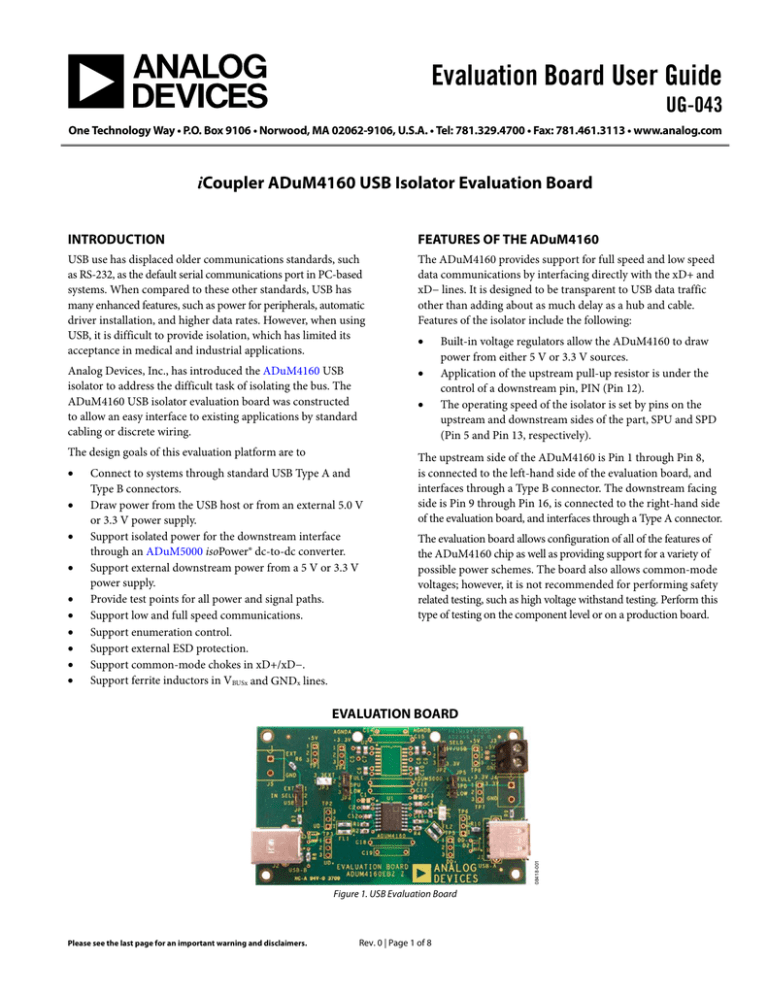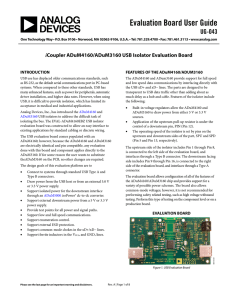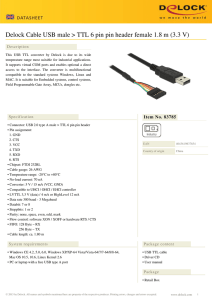
Evaluation Board User Guide
UG-043
One Technology Way • P.O. Box 9106 • Norwood, MA 02062-9106, U.S.A. • Tel: 781.329.4700 • Fax: 781.461.3113 • www.analog.com
iCoupler ADuM4160 USB Isolator Evaluation Board
INTRODUCTION
FEATURES OF THE ADuM4160
USB use has displaced older communications standards, such
as RS-232, as the default serial communications port in PC-based
systems. When compared to these other standards, USB has
many enhanced features, such as power for peripherals, automatic
driver installation, and higher data rates. However, when using
USB, it is difficult to provide isolation, which has limited its
acceptance in medical and industrial applications.
The ADuM4160 provides support for full speed and low speed
data communications by interfacing directly with the xD+ and
xD− lines. It is designed to be transparent to USB data traffic
other than adding about as much delay as a hub and cable.
Features of the isolator include the following:
Analog Devices, Inc., has introduced the ADuM4160 USB
isolator to address the difficult task of isolating the bus. The
ADuM4160 USB isolator evaluation board was constructed
to allow an easy interface to existing applications by standard
cabling or discrete wiring.
•
The design goals of this evaluation platform are to
The upstream side of the ADuM4160 is Pin 1 through Pin 8,
is connected to the left-hand side of the evaluation board, and
interfaces through a Type B connector. The downstream facing
side is Pin 9 through Pin 16, is connected to the right-hand side
of the evaluation board, and interfaces through a Type A connector.
•
•
•
•
•
•
•
•
•
•
•
•
Connect to systems through standard USB Type A and
Type B connectors.
Draw power from the USB host or from an external 5.0 V
or 3.3 V power supply.
Support isolated power for the downstream interface
through an ADuM5000 isoPower® dc-to-dc converter.
Support external downstream power from a 5 V or 3.3 V
power supply.
Provide test points for all power and signal paths.
Support low and full speed communications.
Support enumeration control.
Support external ESD protection.
Support common-mode chokes in xD+/xD−.
Support ferrite inductors in VBUSx and GNDx lines.
Built-in voltage regulators allow the ADuM4160 to draw
power from either 5 V or 3.3 V sources.
Application of the upstream pull-up resistor is under the
control of a downstream pin, PIN (Pin 12).
The operating speed of the isolator is set by pins on the
upstream and downstream sides of the part, SPU and SPD
(Pin 5 and Pin 13, respectively).
The evaluation board allows configuration of all of the features of
the ADuM4160 chip as well as providing support for a variety of
possible power schemes. The board also allows common-mode
voltages; however, it is not recommended for performing safety
related testing, such as high voltage withstand testing. Perform this
type of testing on the component level or on a production board.
08418-001
EVALUATION BOARD
Figure 1. USB Evaluation Board
Please see the last page for an important warning and disclaimers.
Rev. 0 | Page 1 of 8
UG-043
Evaluation Board User Guide
TABLE OF CONTENTS
Introduction ...................................................................................... 1 Speed Selection ..............................................................................4 Features of the ADuM4160 ............................................................. 1 Pull-Up Control .............................................................................4 Evaluation Board .............................................................................. 1 Series Resistors...............................................................................4 Revision History ............................................................................... 2 Test Points ......................................................................................4 Power .................................................................................................. 3 Optional Components ..................................................................4 Upstream Side ............................................................................... 3 Evaluation Board Schematic and Artwork.....................................5 Downstream Side.......................................................................... 3 ESD Caution...................................................................................8 Grounding Scheme....................................................................... 3 REVISION HISTORY
2/10—Revision 0: Initial Version
Rev. 0 | Page 2 of 8
Evaluation Board User Guide
UG-043
POWER
UPSTREAM SIDE
The USB standard requires that the upstream facing port of a
peripheral device derive power for its pull-up from the 5 V present
on the cable. Power can also be used to power functions in the
peripheral at up to 500 mA.
The ADuM4160 contains an internal voltage regulator that can
derive the 3.3 V from VBUSx for use in the data transmission and
pull-up power. It also provides the user with the ability to bypass
this regulator if a 3.3 V supply can be provided by the user. The
evaluation board can choose to source its power from the cable
at 5 V or from an external supply connected to terminal block
J5, labeled EXT. Jumper JP1 selects between the two sources.
When the external power is chosen, the ADuM4160 can be
configured to accept either 3.3 V or 5 V from that source. If
3.3 V is supplied, then the internal regulator must be disabled
by shorting Pin 1 and Pin 3 together. This is accomplished by
placing a shunt across JP3, labeled 3.3EXT. This jumper should
be open when the USB bus is the source of power.
Table 1. Upstream Power Jumper Settings
Power Source
USB bus
EXT 5.0 V
EXT 3.3 V
Jumper Settings
IN SELU (JP1)
3.3EXT (JP3)
USB (2 and 3)
Open
EXT (1 and 2)
Open
EXT (1 and 2)
Short
The ADuM5000 is only capable of providing 100 mA of power
to the downstream side. Applications that require more power
at the downstream port must use the external power option.
The ADuM5000 has been provided for the convenience of the
user, and its use in final applications should be reviewed based
on its data sheet precautions for power consumption and EMI
mitigation.
Configuration of the downstream power is accomplished by
installing or uninstalling the ADuM5000 converter, applying
power to J3 or J4, and setting the appropriate jumper.
As with the upstream side of the ADuM4160, there is an internal
regulator that derives the 3.3 V supply for the xD+ and the xD−
signal lines from a 5 V source applied to VBUS2. In addition, if
VBUS2 and VDD2 are connected together to a 3.3 V source, the
regulator is bypassed, and the voltage is used directly by the
chip. The IN SELD (JP2) jumper selects between getting power
from a 5 V source and a 3.3 V source. The 5 V source can either
be an external voltage applied to J3 or an ADuM5000. The only
3.3 V source is the terminal block J4. If external power is used,
the ADuM5000 must not be installed on the board.
Table 2. Downstream Power Jumper Settings
Power Source
USB bus
5 V (J3)
3.3 V (J4)
DOWNSTREAM SIDE
The USB standard does not allow any power to be sourced
from a peripheral port. Power to run the downstream side of
the ADuM4160 cannot come from the cable connection as it
did on the upstream facing side. If the ADuM4160 is built into
a peripheral device, it can receive power directly from the power
supply of the peripheral. If the ADuM4160 is not built into the
peripheral that it is protecting, then power must be provided
from an external source or derived from the upstream bus power
through a dc-to-dc converter. All of these possible power
configurations are addressed in the evaluation board.
Power for the downstream port can be provided from external
power supply connections through Terminal Block J3 and
Terminal Block J4 or from the upstream USB power bus through
an ADuM5000 isoPower dc-to-dc module that can be ordered
separately. To make the board design robust and as simple as
possible, only one method of powering the board can be used.
The evaluation board comes configured to accept an external
5 V supply. If the downstream port is powered from the peripheral
or an external supply, an ADuM5000 should not be installed.
Jumper Settings/Components
IN SELD (JP3)
ADuM5000
5 V/USB
Installed
5 V/USB
Not Installed
3.3 V
Not Installed
GROUNDING SCHEME
The board consists of two separate ground and power systems.
In addition, there is a floating capacitive structure on the bottom
layer of the PCB that provides for EMI mitigation for the
ADuM5000 dc-to-dc converter. This structure consists of a
floating plane on each side of the isolation boundary. To allow
evaluation of different EMI mitigation schemes, the planes can be
for example
•
•
•
Rev. 0 | Page 3 of 8
Left floating which has a minimal effect on EMI.
Connected by adding a strip of copper tape and soldering it
to the exposed pads.
Connected by safety capacitors installed in through-hole
positions, C14 and C19.
UG-043
Evaluation Board User Guide
In addition, the ground and power planes can be capacitively
linked via C15 to C18 at the user’s option. This can provide planeto-plane noise bypassing through several paths to reduce radiated
emissions from the ADuM5000 power supply.
There are two large screw holes along the top edge of the PCB
that provide connection to the upstream ground plane and the
downstream ground plane. These are provided to allow grounding
of the PCB to the system in multiple configurations. The floating
planes are designed with 0.4 mm of setback to all vias and other
board planes. The PCB should not be used for high voltage testing
if the floating structures are employed for noise reduction. If this
type of structure is required in a final design, it should be built
on an inner layer of the PCB to avoid creepage and clearance issues.
Table 4. PIN Pull-Up Control
PIN (JP5)
Short
Open
Upstream Pull-Up State
Disconnected
Connected
SERIES RESISTORS
The two USB speeds supported by the ADuM4160 require
different series resistance values at the transceiver terminals.
For full speed operation, Resistor R1 to Resistor R4 should be
populated with 24 Ω, 1% resistors. These are installed in the
base configuration of the evaluation board, and if the board is
operated at full speed, no changes are required.
The ADuM4160 works at a fixed USB transmission speed, either
low speed or full speed. The speed is set by the SPU and SPD
pins on the upstream and downstream sides of the part and must
be set by jumpers on the evaluation board. Both speed jumpers
must be set to the same speed setting for proper operation.
For low speed operation, R1 to R4 should be replaced by 0 Ω
shunts. If the board is operated at a low speed, it must be modified
from the as-received configuration. The shunt can be an 805size SMT device or a simple wire shorting the pads. The resistors
do not significantly affect the low speed performance and may
be left in place for both speed modes, if impedance is not
critical to the evaluation.
Table 3. Speed Selection Jumpers
TEST POINTS
SPEED SELECTION
SPU (JP4)
Short SPU-Full
Short SPU-Low
SPD (JP5)
Short SPD-Full
Short SPD-Low
Speed
Full (12 Mbps)
Low (1.5 Mbps)
PULL-UP CONTROL
The PIN pin is provided to allow the control of enumeration and
disconnect by the peripheral. When PIN is logic high, the pull-up
on the upstream side of the ADuM4160 is applied to the data
line appropriate for the USB speed mode. This allows enumeration
and data transmission. When PIN is logic low, the upstream
pull-up is disconnected, making the upstream port behave as
though the port was not present.
This function is provided to allow the peripheral to delay
communication with the host by delaying application of the
upstream pull-up resistor until it is ready to be enumerated on
the bus. If this functionality is not required, then PIN can be
tied to VDD2, and the pull-up is applied to the upstream side
when power is applied to both the downstream power supplies.
Control of PIN is provided through Jumper JP6. The PIN input
is pulled high by a 10 kΩ resistor. When a shunt is placed across
JP6, it is pulled low. This provides a default state of high to PIN,
allowing immediate enumeration.
Positions for eight test points are included on the evaluation board.
No headers are provided in the default configuration. Mounting
holes for a ground signal pair are provided. The holes fit a standard
square-pin spaced at 100 mil or 200 mil on center. This configuration
was chosen to match the dimensions of the Tektronix high frequency
active probes or standard headers. An appropriate scope header
can be obtained by using 3-pin SIP wire wrap header and removing
the center pin. The signal pin can be trimmed to match the spacing
of the probe. If another type of connection is required, wires
can be inserted into the holes provided for these connections.
OPTIONAL COMPONENTS
Options for installing common-mode chokes and external ESD
protection on the DD+/DD− and UD+/UD− data lines are also
available. Positions for TDK ACM3225 chokes are provided at
Position FL1 and Position FL2. Positions for ESD diode packs,
NUP2202 from ON Semiconductor, are provided at Position D1
and Position D2. In addition, pads for surface-mount ferrite
inductors are provided at Position R6 to Position R10. All of
these component positions are either unpopulated or filled
with 0 Ω resistors from Analog Devices. They are on the PCB
as a convenience to the end user.
Rev. 0 | Page 4 of 8
1
2
3
4
USB-B-S-F-B-TH-R
J2
WEILAND25.161.0253
AGND_A
TBD0805
R8
TP3
TP2
AGND_A
MOLEX22-03-2031
MOLEX22-03-2031
TP1
JP1
TBD0805
R6
MOLEX22-03-2031
TBD0805
1
2
DNI
1
2
3
1
VN
IO1
AGND_A
MOLEX22-03-2031
DNI
1
2
3
DNI
1
2
3
1
2
3
2
J5
5
VP
NC
+5V
AGND_A
1
2
6
DNI TP4
1
2
3
+5V
MOLEX22-03-2031
NUP2202W1T2G
IO2
D1
1
4
1
2
3
2
JP4
MOLEX22-03-2031
JP3
3
FL1
+5V
BERG69157-102
4
3
R7
AGND_A
16
15
14
13
12
11
10
9
PCB
CAP
1
C14
1
C19
TBD_SPACER_400
AGNDA
K24A
FOR 24 OHM 1% USE 0603
FOR 0 OHM USE 0805
R1-R4 TBD 0805
AGND_A
TBD_SPACER_400
C18
GEN_SO16WB
ADUM4160
U1
C10
0.1UF
VISO
C8
0.1UF
AGND_B
PCB
CAP
AGNDB
K24A
R4
10K
R5
C4
TBD0805
C9
10UF
TBD0805
TBD0805
R3
VISO
C3
0.1UF
AGND_B
TBD_SPACER_400
TBD_SPACER_400
AGND_A
C17
16
15
14
13
12
11
10
9
U2
GEN_SO16WB
ADUM5000
C16
1
2
3
4
5
6
7
8
TBD_SPACER_400
C1
C2
TBD0805 0.1UF
1
+5V
C12
2
0.1UF
VDD 3
4
5
R1
6
R2 TBD0805
7
8
TBD0805
AGND_A
C6
0.1UF
C7
0.1UF
+5V
4
3
C11
0.1UF
FL2
1
VN
IO1
270 OHMS
AGND_B
VISO
AGND_B
5
VP
NC
VISO
1
2
C13
10UF
DNI
MOLEX22-03-2031
JP2
AGND_B
DNI
1
2
3
1
2
3
R9
TP5
WEILAND25.161.0253
J3
AGND_B
1
2
GND
PINS
J1
AGND_B
87520-0010BLF_ALT
G1
G2
1
2
3
4
WEILAND25.161.0253
J4
AGND_B
JP5
MOLEX22-03-2031
TBD0805
MOLEX22-03-2031
DNI
TP6
1
2
3
AGND_BMOLEX22-03-2031
BERG69157-102
JP6
NUP2202W1T2G
6
D2
IO2
1
2
2
3
MOLEX22-03-2031
TP7
1
1
2
3
TP8
DNI
1
2 MOLEX22-03-2031
3
AGND_B
1
2
R10
C5
10UF
TBD0805
AGND_A
2
Figure 2. Evaluation Board Schematic
4
3
270 OHMS
Rev. 0 | Page 5 of 8
08418-002
C15
Evaluation Board User Guide
UG-043
EVALUATION BOARD SCHEMATIC AND ARTWORK
Evaluation Board User Guide
08418-003
UG-043
Figure 3. Evaluation Board Artwork
Rev. 0 | Page 6 of 8
Evaluation Board User Guide
UG-043
NOTES
Rev. 0 | Page 7 of 8
UG-043
Evaluation Board User Guide
NOTES
ESD CAUTION
Evaluation boards are only intended for device evaluation and not for production purposes. Evaluation boards are supplied “as is” and without warranties of any kind, express,
implied, or statutory including, but not limited to, any implied warranty of merchantability or fitness for a particular purpose. No license is granted by implication or otherwise under
any patents or other intellectual property by application or use of evaluation boards. Information furnished by Analog Devices is believed to be accurate and reliable. However, no
responsibility is assumed by Analog Devices for its use, nor for any infringements of patents or other rights of third parties that may result from its use. Analog Devices reserves the
right to change devices or specifications at any time without notice. Trademarks and registered trademarks are the property of their respective owners. Evaluation boards are not
authorized to be used in life support devices or systems.
©2010 Analog Devices, Inc. All rights reserved. Trademarks and
registered trademarks are the property of their respective owners.
UG08418-0-2/10(0)
Rev. 0 | Page 8 of 8



